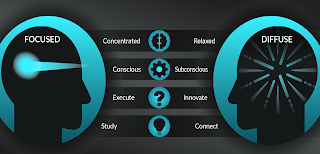Diffused and Focused Thinking
FOCUSED THINKING.
- Barbara Oakley, the academic and author responsible for popularizing this model, describes Focused Thinking as dependent on established neural pathways and existing thought patterns. It’s the type of thinking you access to understand and solve familiar problems as well as to study a concept.
- The strength of Focused Thinking lies in its ability to analyze and solve problems in a sequential manner. It’s likely you’re applying a level of Focused Thinking as you read these words and try to understand this model.
DIFFUSE THINKING.
- Diffuse Thinking is what happens when your mind relaxes, providing space for daydreaming and wandering thoughts. That's something that many people miss or undervalue — it's the fact that even when your conscious mind stops concentrating on something, your brain will continue to process, ponder and think.
- Rather than being focused on a defined path, Diffuse Thinking allows your subconscious to make unexpected connections between disparate ideas. As a result, it can help you to develop innovative solutions and learn by connecting new and unfamiliar concepts with existing ones.
- You’ll often experience Diffuse Thinking when you go for a walk, have a shower, take a long drive in the country, or just stare out the window.

Comments
Post a Comment